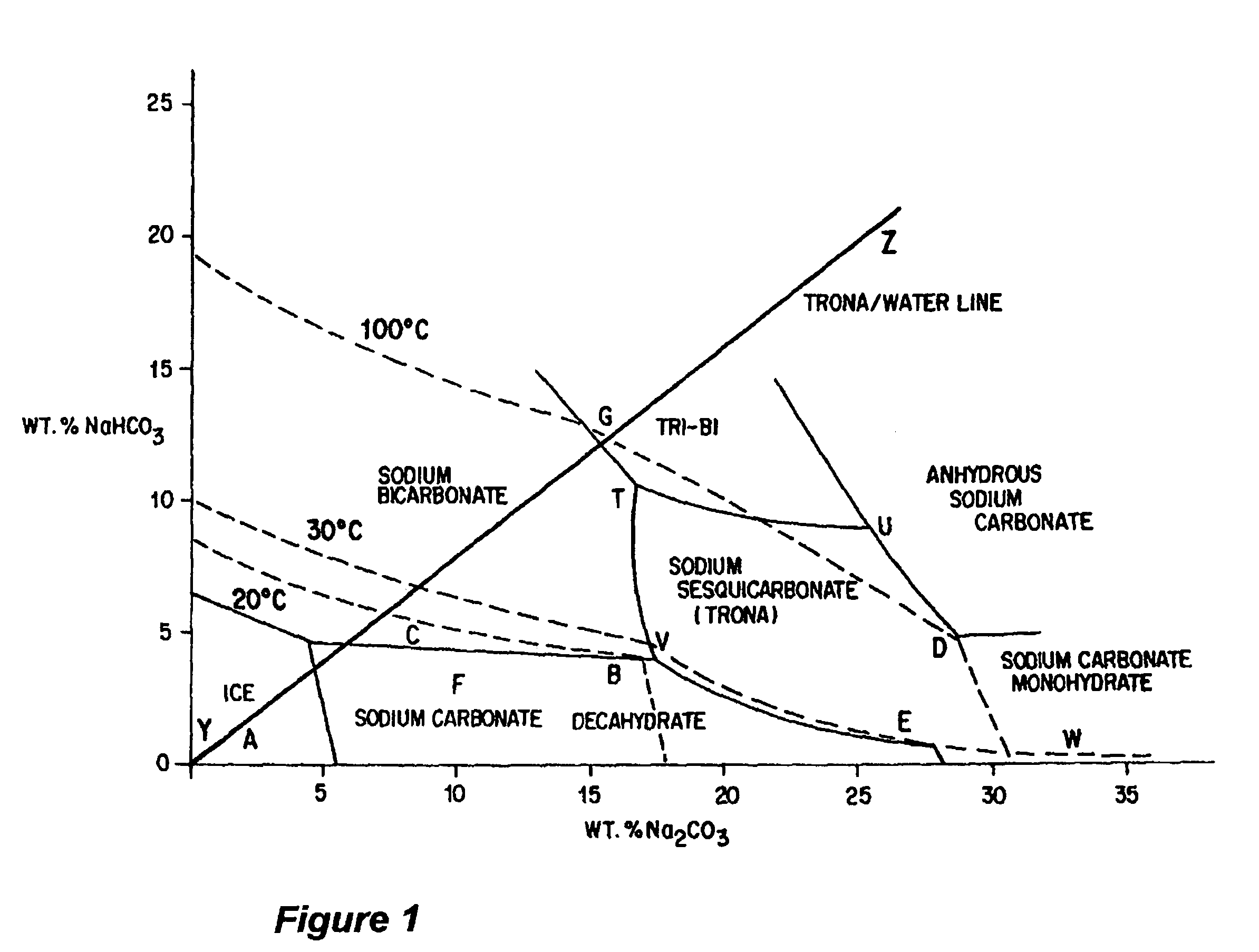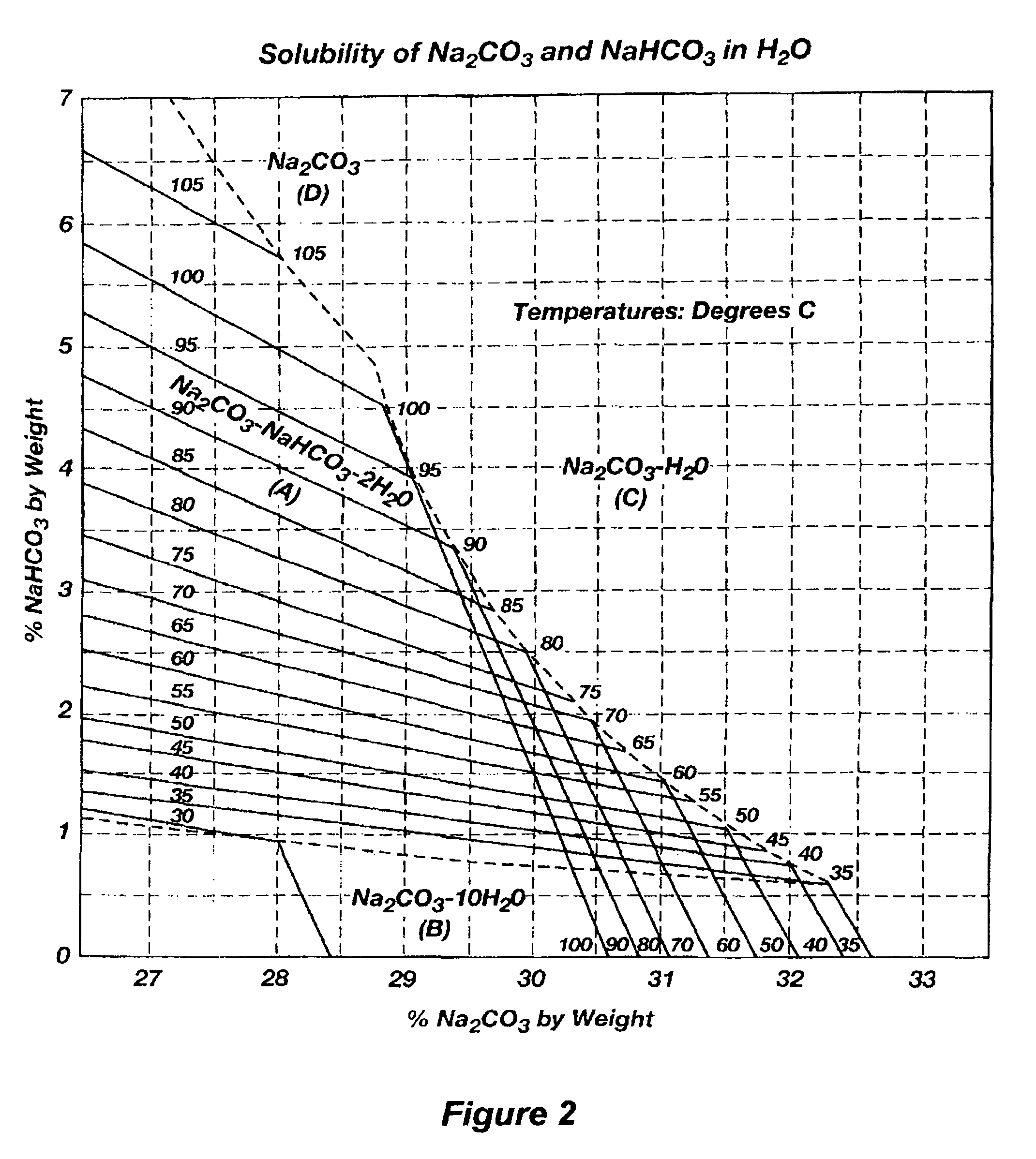Production of sodium sesquicarbonate and sodium carbonate monohydrate
a technology of sodium sesquicarbonate and sodium carbonate, which is applied in the direction of alkali metal carbonates, alkali metal sulfites/sulfates, borehole/well accessories, etc., can solve the problems of unrecovered a significant fraction of trona ore in the bed being mined, and the mining method is typically complicated and laborious
- Summary
- Abstract
- Description
- Claims
- Application Information
AI Technical Summary
Benefits of technology
Problems solved by technology
Method used
Image
Examples
example 1
[0142]Example 1 illustrates one aspect of the process of this invention in which sodium sesquicarbonate and sodium carbonate monohydrate are produced from an aqueous minewater effluent stream that is at ambient temperature, 18° C. In this Example 1, the two products are processed further to make soda ash (sodium carbonate), the sodium sesquicarbonate being calcined to make light soda ash and the sodium carbonate monohydrate being dried to make dense soda ash. The Example describes a continuously-operated process in which the annual output is 100,000 tons (2×108 lbs) soda ash per year.
[0143]As will be shown in the detailed description that follows, the process of this Example 1 is noteworthy for the following:[0144]58% of the total soda ash output is light soda ash, from calcined sodium sesquicarbonate, and 42% is dense soda ash, from sodium carbonate monohydrate[0145]total alkali (sodium carbonate) recovery from the aqueous minewater feed stream is high, about 89%[0146]aqueous minew...
example 2
[0163]Example 2 illustrates another aspect of the process of this invention, similar to that of Example 1, to demonstrate that the process is readily adapted for use with an aqueous minewater effluent stream that has an elevated temperature, 60° C., instead of ambient temperature, 18° C., used in Example 1.
[0164]In other respects, the parameters of this Example 2 are similar to that of Example 1. The sodium sesquicarbonate and sodium carbonate monohydrate crystallization products are processed further to make soda ash, in a continuous process having an annual output of 100,000 tons soda ash per year. In addition, the aqueous minewater effluent is again concentrated in a preliminary evaporation step, the sodium sesquicarbonate is again produced in a cooling crystallizer, at a crystallizer composition that is on the right side of the sesquicarbonate region of the phase diagram, and some of the sesquicarbonate mother liquor is recycled to the evaporation step. Minewater is again reacte...
example 3
[0180]Example 3 illustrates yet another aspect of the process of this invention, in which the sodium sesquicarbonate crystallization operation is modified to reduce the overall percentage soda ash that is light density soda ash, significantly raising production of dense soda ash, from sodium carbonate monohydrate. This Example 3 uses the same aqueous minewater effluent stream that is used in Example 1, at ambient temperature, 18° C.
[0181]The parameters of this Example 3 are similar to that of Example 1 in the following respects. The sodium sesquicarbonate and sodium carbonate monohydrate crystallization products are processed further to make soda ash, in a continuous process having an annual output of 100,000 tons soda ash per year. In addition, the aqueous minewater effluent is again concentrated in a preliminary evaporation step, and the sodium sesquicarbonate is again produced in a cooling crystallizer operation.
[0182]Noteworthy aspects and significant differences in this Example...
PUM
| Property | Measurement | Unit |
|---|---|---|
| temperatures | aaaaa | aaaaa |
| temperatures | aaaaa | aaaaa |
| temperature | aaaaa | aaaaa |
Abstract
Description
Claims
Application Information
 Login to View More
Login to View More - R&D
- Intellectual Property
- Life Sciences
- Materials
- Tech Scout
- Unparalleled Data Quality
- Higher Quality Content
- 60% Fewer Hallucinations
Browse by: Latest US Patents, China's latest patents, Technical Efficacy Thesaurus, Application Domain, Technology Topic, Popular Technical Reports.
© 2025 PatSnap. All rights reserved.Legal|Privacy policy|Modern Slavery Act Transparency Statement|Sitemap|About US| Contact US: help@patsnap.com



